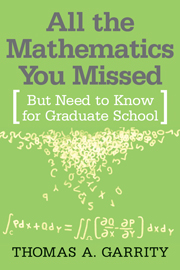Book contents
- Frontmatter
- Contents
- Preface
- On the Structure of Mathematics
- Brief Summaries of Topics
- 1 Linear Algebra
- 2 ∈ and δ Real Analysis
- 3 Calculus for Vector-Valued Functions
- 4 Point Set Topology
- 5 Classical Stokes' Theorems
- 6 Differential Forms and Stokes' Thm.
- 7 Curvature for Curves and Surfaces
- 8 Geometry
- 9 Complex Analysis
- 10 Countability and the Axiom of Choice
- 11 Algebra
- 12 Lebesgue Integration
- 13 Fourier Analysis
- 14 Differential Equations
- 15 Combinatorics and Probability
- 16 Algorithms
- A Equivalence Relations
- Bibliography
- Index
10 - Countability and the Axiom of Choice
Published online by Cambridge University Press: 11 April 2011
- Frontmatter
- Contents
- Preface
- On the Structure of Mathematics
- Brief Summaries of Topics
- 1 Linear Algebra
- 2 ∈ and δ Real Analysis
- 3 Calculus for Vector-Valued Functions
- 4 Point Set Topology
- 5 Classical Stokes' Theorems
- 6 Differential Forms and Stokes' Thm.
- 7 Curvature for Curves and Surfaces
- 8 Geometry
- 9 Complex Analysis
- 10 Countability and the Axiom of Choice
- 11 Algebra
- 12 Lebesgue Integration
- 13 Fourier Analysis
- 14 Differential Equations
- 15 Combinatorics and Probability
- 16 Algorithms
- A Equivalence Relations
- Bibliography
- Index
Summary
Basic goal: Comparing infinite sets
Both countability and the axiom of choice grapple with the elusive notions behind “infinity”. While both the integers Z and the real numbers R are infinite sets, we will see that the infinity of the reals is strictly larger than the infinity of the integers. We will then turn to the Axiom of Choice, which, while straightforward and not an axiom at all for finite sets, is deep and independent from the other axioms of mathematics when applied to infinite collections of sets. Further, the Axiom of Choice implies a number of surprising and seemingly paradoxical results. For example, we will show that the Axiom of Choice forces the existence of sets of real numbers that cannot be measured.
Countability
The key is that there are different orders or magnitudes of infinity. The first step is to find the right definition for when two sets are of the same size.
Definition 10.1.1A set A is finite of cardinality n if there is a one-to-one onto function from the set {1,2,3, …, n} to A. The set A is countably infinite if there is a one-to-one onto function from the natural numbersN = {1,2,3, …,} to A. A set that is either finite or countably infinite is said to be countable. A set A is uncountably infinite if it is not empty and not countable.
- Type
- Chapter
- Information
- All the Mathematics You MissedBut Need to Know for Graduate School, pp. 201 - 212Publisher: Cambridge University PressPrint publication year: 2001



